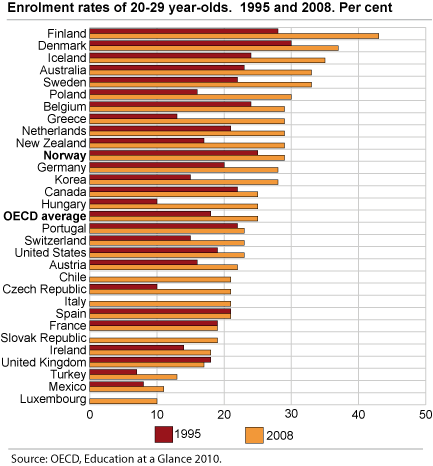Indicators on education in the OECD, academic year 2007/2008
Increase of 20-29 year olds in education
Published:
On average for OECD-countries, 25 per cent of the age group 20-29 year-olds was enrolled in education in 2008 – an increase by nearly 8 percentage points compared with 1995. There were also significant differences in educational attainment between age groups.
- Series archive
- Indicators on education in the OECD
In each of the Nordic countries at least 29 per cent of this age group was in education, and as many as 43 per cent in Finland and 37 per cent in Denmark. The lowest participation rates for this age group were found in Mexico, Turkey and United Kingdom – 11, 13 and 17 per cent respectively.

In the age group 15-19 years 82 per cent was enrolled in education as an average for OECD-countries. In Norway, 87 per cent of this age group was in education. In seven OECD-countries, as in Brazil, Israel and Russia, less than 80 per cent of 15-19 year-olds was in education. The various enrolment patterns for this age group is partly explained by the different ages at which compulsory education ends – from the age of 14 in some countries to 18 in others.
Differences in educational attainment between age groups
On average across OECD-countries, 80 per cent of all 25-34 year-olds had completed at least upper secondary education in 2008, compared with 58 per cent for the age group 55-64 years – a difference by 22 percentage points. The largest difference between the two age groups was found in South-Korea, where 98 per cent of the population aged 25-34 had completed at least upper secondary education and 40 per cent of the population aged 55-64.
Differences between the age groups are less pronounced in countries with generally high levels of educational attainment. The difference was on average 12 percentage points for twelve OECD-countries where more than 80 per cent of all adults (25-64 year-olds) had at least upper secondary education. In Norway, 84 per cent of the population aged 25-34 had completed this level, and 78 per cent of all 55-64 year-olds.
Five countries hosted half of the world’s students who studied abroad
The five most popular host countries for students studying abroad in 2008 were United States, United Kingdom, Australia, France and Germany – hosting 50 per cent of all students studying abroad in 2008. United States hosted 19 per cent of all students studying abroad, 10 per cent studied in United Kingdom and 7 per cent studied in each of the countries Australia, France and Germany. The most popular countries for Norwegian students studying abroad were United Kingdom (21 per cent) and Denmark (18 per cent).
A number of countries have noticed a drop as a preferred destination of foreign students over the last decade. The most notable decline was in the United States – from almost 26 per cent in 2000 to 19 per cent in 2008. More than 3.3 million students were studying abroad in 2008, and Norway hosted approximately 16 000 of these students – a proportion of 0.5 per cent of all foreign students.
The statistics are taken from Education at a Glance 2010 , published by the OECD.
Tables
Contact
-
Statistics Norway's Information Centre
